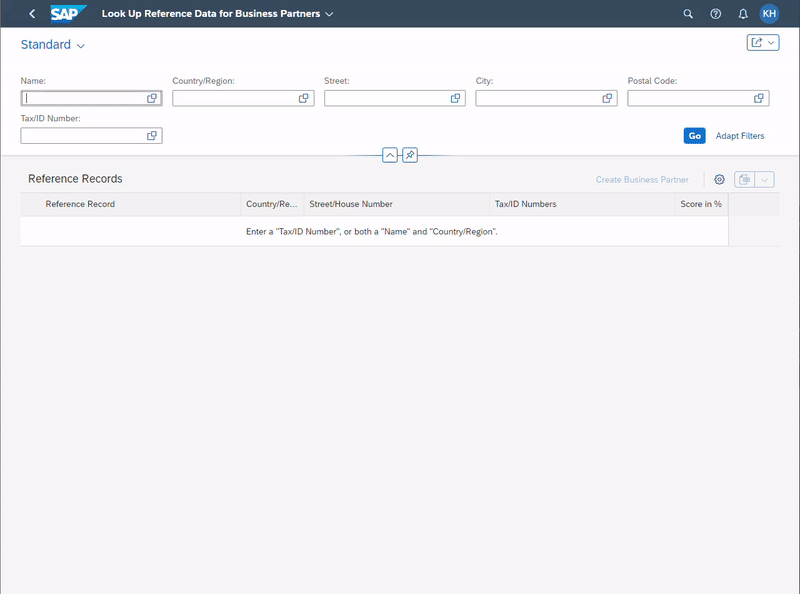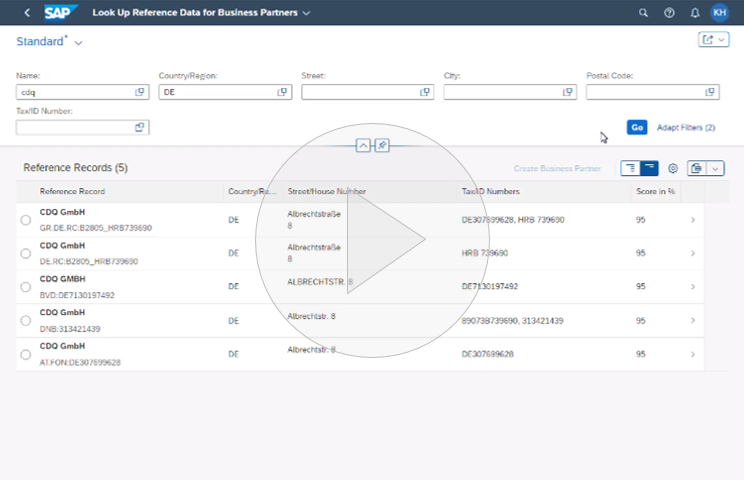Mastering Business Partners in SAP: First Time Right with Trusted Data

In many companies, maintaining SAP business partner data can be a tedious task involving manual data entry, field by field. Sure, there are some basic validation checks in place for things like postal codes and country selection, but when it comes to entering names, addresses, and tax identification numbers, it's all done by hand.
What's even more frustrating is that much of this data is already available from trusted sources like trade registers, tax authorities, and global standardization organizations. And due to compliance requirements, guided procedures often mandate the use of trusted data sources – however, not nicely integrated into a workflow but to take screenshots for proving the validity of manually-entered data.
Now, integrating these external sources would certainly help. But with so many different sources out there, each with its own unique data models and field semantics, mapping it all back to SAP can be a real headache. And unless you're dealing with thousands of business partners per month, manual error-prone data entry might be considered the better business case.
But there is good news: SAP now provides standard functionality for integrating external data sources into business partner creation processes with the cloud edition of SAP Master Data Governance. This means streamlined access to external data from trusted providers, ensuring First Time Right for SAP Business Partners. With this functionality, data maintenance becomes faster, more accurate, and more compliant than ever before. Let's dive into some examples to see just how effective this functionality can be.
Consistent access to data from various sources
The figure shows the search result for "CDQ" in Germany (DE) with 5 found reference records. Under the company name of each item, the prefix of the record ID indicates the data source for the corresponding record. For instance, "DE.RC" stands for the German Register of Commerce, "DNB" represents Dun and Bradstreet, "BVD" denotes Bureau von Dijk, and "AT.FON" refers to Austrian FinanzOnline. The first item is marked with "GR", Golden Record, a consolidated version of the data from all other records using a prioritization logic.

After selecting a reference record, its data is automatically populated in a standard business partner creation form. This allows the user to edit or extend the record before completing its creation.

One of the key highlights of this solution is that the identifiers of various data sources are mapped to SAP's standard tax categories and identification types. These mappings can be customized to comply with corporate standards, but they also work out-of-the-box for most commonly used identifiers. In the example, the ID of the German Register of Commerce is mapped to BUP002, which is the SAP identification type for business register numbers in general.

The following videos show the entire sequence of how to lookup reference data and process it within an actual business partner creation workflow.


Even more identifiers with the Golden Record
As the search result for “CDQ” in Germany (DE) shows, multiple relevant reference records for a particular business partner may appear across various data sources. The Golden Record feature addresses this issue by consolidating information from multiple sources into one consistent record, with a prioritization of data sources that is customizable and country-specific. As shown in the figure below, the European VAT number is included with information from the German Register of Commerce and mapped to the SAP tax category DE0.

Integrated data sources are not limited to German or European authorities, but include a variety of sources from around the world. For example, the Legal Entity Identifier (LEI) in the following example is just one of many IDs that can be accessed. Trusted data sources from various US state registers, Brazil, Australia, and other countries are also available. To view a list of all available data sources, please browse here.

Instead of relying on screenshots to prove data validity, lookup requests and the direct responses from trusted data sources can be automatically logged for audit trails.
Conclusion
With SAP Master Data Governance, cloud edition, SAP provides standard functionality for streamlined access to external data from trusted providers, making data maintenance faster, more accurate, and compliant. The solution provides consistent access to data from various sources and also offers the option to consolidate information from multiple sources into a Golden Record. The integrated data sources are not limited to German or European authorities but include various trusted sources from around the world.
Further readings on external data
Sourcing and managing external data (CDQ AG)
External data is an underexploited resource (Competence Center Corporate Data Quality)
Harnessing the power of external data (McKinsey)
***This article was originally published on LinkedIn. Follow Kai for more insights on data quality!***

Get our e-mail!
Related blogs
Trust, automation, and the future of master data management
Master data management (MDM) is a vital, albeit often underappreciated, foundation of modern business operations. When done right, it ensures smooth processes,…
The value of automation in MDM: podcast CDQ & SAP
Efficient mass-enrichment of business partner data in SAP MDG
Managing and enriching business partner data at scale is a monumental task for many organizations, particularly during mergers, acquisitions, or large-scale…





